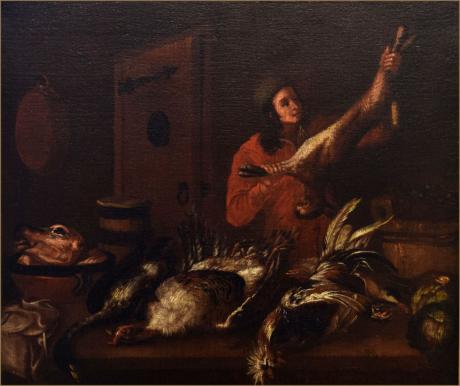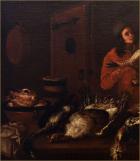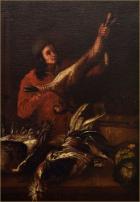A game larder, also sometimes known as a deer or venison larder, deer, venison or game house, game pantry or game store, is a small domestic outbuilding where the carcasses of game, including deer, game birds, hares and rabbits, are hung to mature in a cool environment. A feature of large country houses in Britain and parts of northern Europe from the 18th century, game larders continue to be used by shooting estates.
A separate building for storing game during the maturation process improves ventilation, while reducing the odour problem. Most large country houses in Britain had a game larder, and numerous examples built between the early 18th and early 20th centuries survive. The structure also existed in other European countries where hunting or shooting game was popular, including Germany and Austria–Hungary.
Game larders were usually situated near the kitchen.The usual English design is single storey, sometimes octagonal, and usually of brick or stone construction; ventilation is provided by louvred roof lanterns and louvred or mesh-covered unglazed windows.Some game larders had separate rooms for small and large game. A stone or slate floor helped to cool the room. By the early 20th century, refrigeration via cooling pipes was employed. Game larders were sometimes combined with other outbuildings, especially ice houses, as for example atElvaston Castle in Derbyshire and Raith Park in Fife. In central Europe, ice houses were themselves sometimes used for storing deer carcasses. Rails or beams were used to support deer on hooks, with roof-suspended racks, sometimes on pulleys, for small game. Shelves, possibly of marble, were also used. Another necessary fixture described by Victorian architectRobert Kerr is a dresser topped with slate or marble for meat preparation. A relatively early example is the game larder at Farnborough Hall, Warwickshire, which dates from around 1750 and is thought to be by Sanderson Miller; the hexagonal rendered-brick structure has a loggia with Tuscan columns and is surmounted with a wooden cupola. An example of an unornamented square game larder stands at Studley Park in Yorkshire; built in limestone, it dates from the late 18th century.The square stone game larder at Rydal Hall in Cumbria has a timber upper storey reached by an external staircase. Although most extant game larders are built in stone or brick, some timber examples have survived. Examples include the structures at Brodsworth Hall, Yorkshire, Audley End House, Essex, and the Bird Game Larder at Ardverikie House, Badenoch and Strathspey.



